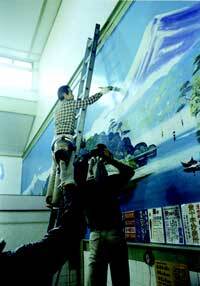ご自宅のお風呂の壁に貼ることができる銭湯背景画のポスターを販売しています。 水に濡らすだけでお風呂の壁に何度でも貼ることができる特殊な印刷紙を使用しています。 水に濡れても破れることはありません。
都内では数十軒の公衆浴場でしか見られなくなってしまったペンキ絵を皆様のご自宅のお風呂の壁に貼って昭和の心のふるさとをお楽しみください。
背景絵師 佐怒賀 次男 (Tsugio Sanuga)
昭和34年 背景画第一号を文京区の銭湯にて描き、以来およそ30年間に9000点もの背景画を描きました。その後、一度はその道を離れましたが、背景画を後世に保存していく為再び筆をとり、平成3年 公衆浴場背景画保存会の依頼により10分の1の縮小版を作成しました。
歴史 / HISTORY

江戸時代から庶民の憩いの場となってきた公衆浴場に、富士山などのペンキ絵が登場したのは大正時代でした。
銭湯から出て家に帰るまでの湯冷めを防ぐため、少しでも長く入っていられるようにと涼しげな絵を描いたものと言われます。
東京で生まれたペンキ絵は関東を中心に全国に広がり、公衆浴場といえば富士山の背景画というイメージが定着したものの、その後、内湯の普及とともに公衆浴場は減少し、それまで人々に親しまれてきたペンキ絵もだんだん姿を消しタイル絵に変わってきてしまいました。
ENGLISH / 英語
Public bathhouses, or sento, became favorite hangout spots for the common townspeople during the Edo Period. In the early 20th century, bathhouse operators began commissioning huge dynamic landscape murals painted on the walls behind their hot tubs. Dramatic renderings of Mt. Fuji and various cooling coastal scenes soon became synonymous with public bathhouses. Drawn into the soothing landscapes, bathers tended to stay in the hot water longer, thoroughly warming their bodies and thus helping to avoid catching cold on the way home. Public bathhouse landscape paintings quickly spread from Tokyo throughout the Kanto Region and eventually all over Japan.
Unfortunately, during the post war years private bathtubs became common items in family homes, and the demand for public bathhouses fell off rapidly. One by one the local sento closed their doors, and the art of bathhouse landscape murals threatened to disappear completely.
Bathhouse landscape murals, once enjoyed by millions of bathers, are an important artistic and cultural resource. The Bathhouse Mural Preservation Society is dedicated to preserving both the murals themselves and the techniques involved in painting them. We hope that a renewed interest in public bathhouses, especially among foreign visitors and residents, will lead to a renaissance in bathhouse murals.
